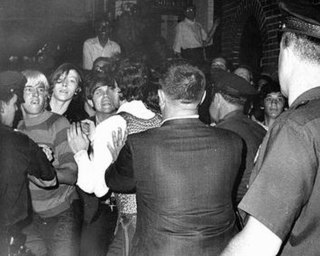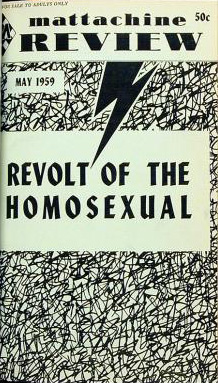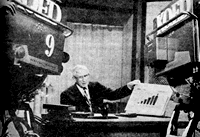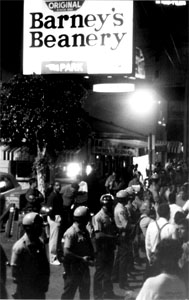Related Research Articles

The Stonewall riots, also known as the Stonewall uprising, Stonewall rebellion, or simply Stonewall, were a series of protests by members of the LGBTQ community in response to a police raid that began in the early morning hours of June 28, 1969, at the Stonewall Inn in the Greenwich Village neighborhood of Lower Manhattan in New York City. Patrons of the Stonewall, other Village lesbian and gay bars, trans activists and unhoused LGBT individuals fought back when the police became violent. The riots are widely considered the watershed event that transformed the gay liberation movement and the twentieth-century fight for LGBT rights in the United States.

The Mattachine Society, founded in 1950, was an early national gay rights organization in the United States, preceded by several covert and open organizations, such as Chicago's Society for Human Rights. Communist and labor activist Harry Hay formed the group with a collection of male friends in Los Angeles to protect and improve the rights of gay men. Branches formed in other cities, and by 1961 the Society had splintered into regional groups.

Henry "Harry" Hay Jr. was an American gay rights activist, communist, and labor advocate. He was a co-founder of the Mattachine Society, the first sustained gay rights group in the United States, as well as the Radical Faeries, a loosely affiliated gay spiritual movement.

The homophile movement is a collective term for the main organisations and publications supporting and representing sexual minorities in the 1950s to 1960s around the world. The name comes from the term homophile, which was commonly used by these organisations. At least some of these organisations are considered to have been more cautious than both earlier and later LGBT organisations; in the U.S., the nationwide coalition of homophile groups disbanded after older members clashed with younger members who had become more radical after the Stonewall riots of 1969.

One, Inc., or One Incorporated, was one of the first gay rights organizations in the United States, founded in 1952.

The gay liberation movement was a social and political movement of the late 1960s through the mid-1980s in the Western world, that urged lesbians and gay men to engage in radical direct action, and to counter societal shame with gay pride. In the feminist spirit of the personal being political, the most basic form of activism was an emphasis on coming out to family, friends, and colleagues, and living life as an openly lesbian or gay person.
The Society for Human Rights was an American gay-rights organization established in Chicago in 1924. Society founder Henry Gerber was inspired to create it by the work of German doctor Magnus Hirschfeld and the Scientific-Humanitarian Committee and by the organisation Bund für Menschenrecht by Friedrich Radszuweit and Karl Schulz in Berlin. It was the first recognized gay rights organization in the United States, having received a charter from the state of Illinois, and produced the first American publication for homosexuals, Friendship and Freedom. A few months after being chartered, the group ceased to exist in the wake of the arrest of several of the Society's members. Despite its short existence and small size, the Society has been recognized as a precursor to the modern gay liberation movement.
This is a list of notable events in the history of LGBT rights that took place worldwide in the 1950s.
This is a list of notable events in the history of LGBT rights that took place in the 1960s.

LGBT pride is the promotion of the self-affirmation, dignity, equality, and increased visibility of lesbian, gay, bisexual, and transgender (LGBT) people as a social group. Pride, as opposed to shame and social stigma, is the predominant outlook that bolsters most LGBT rights movements. Pride has lent its name to LGBT-themed organizations, institutes, foundations, book titles, periodicals, a cable TV channel, and the Pride Library.

Craig L. Rodwell was an American gay rights activist known for founding the Oscar Wilde Memorial Bookshop on November 24, 1967 - the first bookstore devoted to gay and lesbian authors - and as the prime mover for the creation of the New York City gay pride demonstration. Rodwell, who was already an activist when he participated in the 1969 Stonewall uprising, is considered by some to be the leading gay rights activist in the early, pre-Stonewall, homophile movement of the 1960s.
The North American Conference of Homophile Organizations was an umbrella organization for a number of homophile organizations. Founded in 1966, the goal of NACHO was to expand coordination among homophile organizations throughout the Americas. Homophile activists were motivated in part by an increase in mainstream media attention to gay issues. Some feared that without a centralized organization, the movement would be hijacked, in the words of founding member Foster Gunnison Jr., by "fringe elements, beatniks, and other professional non-conformists".
The Annual Reminders were a series of early pickets organized by gay organizations, held yearly from 1965 through 1969. The Reminder took place each July 4 at Independence Hall in Philadelphia and were among the earliest LGBT demonstrations in the United States. The events were designed to inform and remind the American people that gay people did not enjoy basic civil rights protections.
The Janus Society was an early homophile organization founded in 1962 and based in Philadelphia. It is notable as the publisher of Drum magazine, one of the earliest gay publications in the United States and the one most widely circulated in the 1960s, and for its role in organizing many of the nation's earliest LGBT rights demonstrations. The Janus Society takes its name from the Roman two-faced God Janus of beginnings, endings, and doorways. The organization focused on a policy of militant respectability, a strategy demanding respect by showing the public gay individuals conforming to hetero-normative standards of dress at protests.

The Rejected is a made-for-television documentary film about homosexuality, produced for KQED in San Francisco by John W. Reavis. Notable as the first documentary program on homosexuality broadcast on American television, KQED first aired the film on September 11, 1961. Later syndicated to National Educational Television (NET) stations across the United States, it received positive critical reviews.
Henry Gerber was an early homosexual rights activist in the United States. Inspired by the work of Germany's Magnus Hirschfeld and his Scientific-Humanitarian Committee and by the organisation Bund für Menschenrecht by Friedrich Radszuweit and Karl Schulz, Gerber founded the Society for Human Rights (SHR) in 1924, the nation's first known homosexual organization, and Friendship and Freedom, the first known American homosexual publication. SHR was short-lived, as police arrested several of its members shortly after it incorporated. Although embittered by his experiences, Gerber maintained contacts within the fledgling homophile movement of the 1950s and continued to agitate for the rights of homosexuals. Gerber has been repeatedly recognized for his contributions to the LGBT movement.

A zap is a form of political direct action that came into use in the 1970s in the United States. Popularized by the early gay liberation group Gay Activists Alliance, a zap was a raucous public demonstration designed to embarrass a public figure or celebrity while calling the attention of both gays and straights to issues of gay rights.
The Cloistered Order of Conclaved Knights of Sophisticracy, more commonly known as the Knights of the Clock, was an interracial homophile social club based in Los Angeles, California. The Knights were founded by Merton Bird, an African-American man, and W. Dorr Legg, his white lover. Sources differ as to the founding date of the organization, variously citing it as 1949, 1950, and 1951. Regardless of the exact date, the Knights was one of the earliest gay organizations in the United States, with only the Society for Human Rights, the Veterans Benevolent Association and possibly the Mattachine Society pre-dating it.
James "John" Finley Gruber was an American teacher and early LGBT rights activist.

Stuart Timmons was an American journalist, activist, historian, and award-winning author specializing in LGBT history based in Los Angeles, California. He was the author of The Trouble With Harry Hay: Founder of the Modern Gay Movement and the co-author of Gay L.A.: A History of Sexual Outlaws, Power Politics, and Lipstick Lesbians with Lillian Faderman.
References
- Allyn, David (2000). Make Love, Not War: The Sexual Revolution, an Unfettered History. Little, Brown and Company. ISBN 0-316-03930-6.
- Alwood, Edward (1996). Straight News: Gays, Lesbians, and the News Media. Columbia University Press. ISBN 0-231-08437-4.
- Bérubé, Allan (1990). Coming Out Under Fire: The History of Gay Men and Women in World War Two. New York, The Penguin Group. ISBN 0-452-26598-3.
- Bianco, David (1999). Gay Essentials: Facts For Your Queer Brain. Los Angeles, Alyson Books. ISBN 1-55583-508-2.
- Campbell, J. Louis (2007). Jack Nichols, Gay Pioneer: "Have You Heard My Message?". Haworth Press. ISBN 1-56023-653-1.
- Carter, David (2005). Stonewall: The Riots That Sparked the Gay Revolution. Macmillan. ISBN 0-312-34269-1.
- Cleninden, Dudley and Adam Nagourney (1999). Out For Good: The Struggle to Build a Gay Rights Movement in America. New York, Simon & Schuster. ISBN 0-684-81091-3.
- D'Emilio, John (1983). Sexual Politics, Sexual Communities: The Making of a Homosexual Minority in the United States, 1940–1970. Chicago: The University of Chicago Press. ISBN 0-226-14265-5.
- Duberman, Martin (1993). Stonewall. Penguin Books. ISBN 0-525-93602-5.
- Eisenbach, David (2006). Gay Power: An American Revolution. Carroll & Graf Publishers. ISBN 0-7867-1633-9.
- Faderman, Lillian and Stuart Timmons (2006). Gay L.A.: A History of Sexual Outlaws, Power Politics, and Lipstick Lesbians. Basic Books. ISBN 0-465-02288-X.
- Fletcher, Lynne Yamaguchi (1992). The First Gay Pope and Other Records. Boston, Alyson Publications. ISBN 1-55583-206-7.
- Gallo, Marcia M. (2006). Different Daughters: A History of the Daughters of Bilitis and the Rise of the Lesbian Rights Movement. Carroll & Graf Publishers. ISBN 0-7867-1634-7.
- Hogan, Steve and Lee Hudson (1998). Completely Queer: The Gay and Lesbian Encyclopedia. New York, Henry Holt and Company. ISBN 0-8050-3629-6.
- Loughery, John (1998). The Other Side of Silence – Men's Lives and Gay Identities: A Twentieth-Century History. New York, Henry Holt and Company. ISBN 0-8050-3896-5.
- Marks Ridinger, Robert B. (2004). Speaking For Our Lives: Historic Speeches and Rhetoric for Gay and Lesbian Rights (1892-2000). Haworth Press. ISBN 1-56023-175-0.
- Miller, Neil (1995). Out of the Past: Gay and Lesbian History from 1869 to the Present. New York, Vintage Books. ISBN 0-09-957691-0.
- Murray, Stephen O. (1996). American Gay. Chicago, University of Chicago Press. ISBN 0-226-55191-1.
- Stryker, Susan and Jim Van Buskirk, with foreword by Armisted Maupin (1996). Gay by the Bay: A History of Queer Culture in the San Francisco Bay Area. San Francisco, Chronicle Press. ISBN 0-8118-1187-5.
- Teal, Donn (1971, reissued 1995). The Gay Militants: How Gay Liberation Began in America, 1969–1971. New York, St. Martin's Press. ISBN 0-312-11279-3 (1995 edition).
- Timmons, Stuart (1990). The Trouble With Harry Hay. Boston, Alyson Publications. ISBN 1-55583-175-3.
- Tobin, Kay and Randy Wicker (1972). The Gay Crusaders. New York, Paperback Library, a division of Coronet Communications. ISBN 0-446-66691-2.
- Witt, Lynn, Sherry Thomas and Eric Marcus (eds.) (1995). Out in All Directions: The Almanac of Gay and Lesbian America. New York, Warner Books. ISBN 0-446-67237-8.